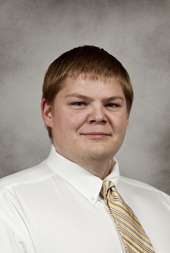 As a high school student considering possible majors, Lander University assistant professor of chemistry Dr. Albert Dukes III had a hard time choosing between chemistry and physics.
As a high school student considering possible majors, Lander University assistant professor of chemistry Dr. Albert Dukes III had a hard time choosing between chemistry and physics.
In the end, he went with chemistry, because it was "more hands-on, and more applicable in terms of benefiting you in life."
The nanocrystal research that he is doing at Lander, where he has taught since earning a Ph.D. from Vanderbilt University in 2011, is a perfect example of what he means.
Nanocrystals -- tiny particles 10,000 times smaller than the width of a hair -- have shown promise as the light-absorbing layer in solar cells. Dukes is trying to determine which molecules can be added to the nanocrystals to facilitate the extraction of electrons and the generation of electricity.
"Traditional solar cells are based on the element silicon and have the potential to be very efficient," explains the Winnsboro native, who was recently named the winner of Lander's Young Faculty Scholar Award for 2013. "However, large, perfect crystals of silicon are needed, and producing such crystals is expensive and difficult. If only a few atoms in the entire silicon crystal are out of place, the efficiency of the device drops off dramatically."
Nanocrystal-based solar cells don't have this problem. They can also "absorb many different wavelengths of light, a property that traditional solar cells lack." He believes that "nanocrystal-based solar cells could become very efficient and make solar power an economically viable alternative to coal for electricity generation."
Dukes and associate professor of chemistry Dr. David Gardner are also investigating the chemical reasons why Mentos candy produces a geyser when dropped into a bottle of Diet Coke. The demonstration has been performed in high school and college science classes for more than a decade, according to Dukes, but "surprisingly little is known about why it works."
Dukes, who said that bubble formation in soft drinks will be integral to the research, hopes that he and his colleague can develop a model for how bubbles form in sodas. "This information could be useful to the food and beverage industry," he said.
Senior chemistry major Bobby Patel is also participating in the research, and Dukes will be assisted in his nanocrystal research this fall by senior chemistry majors Tanner Cameron and Jordan Ashley.
Professor of chemistry Dr. Ralph Layland, who chairs Lander's Department of Physical Sciences, and who is himself collaborating with Dukes in developing new methods of synthesizing semiconductor nanocrystals, commended Dukes for "giving his students the opportunity to be scientists working in a lab."
Layland also praised Dukes, who teaches a broad array of chemistry courses, for being "a great teacher. His dedication to Lander and his profession is always reflected in his student evaluations. Albert sets an example of what good faculty should be."
Asked what he likes about teaching at Lander, Dukes said, "you actually get to know your students." That's helpful, in his view, because different students require different explanations.
Dukes, who is also participating in a study to assess the efficacy of computer-based training methods for laboratory skills, spoke of several goals that he has. One, he said, is "to engage more of our students in doing research." Another, he said, is to continue to do research that's "exciting and engaging and impactful."